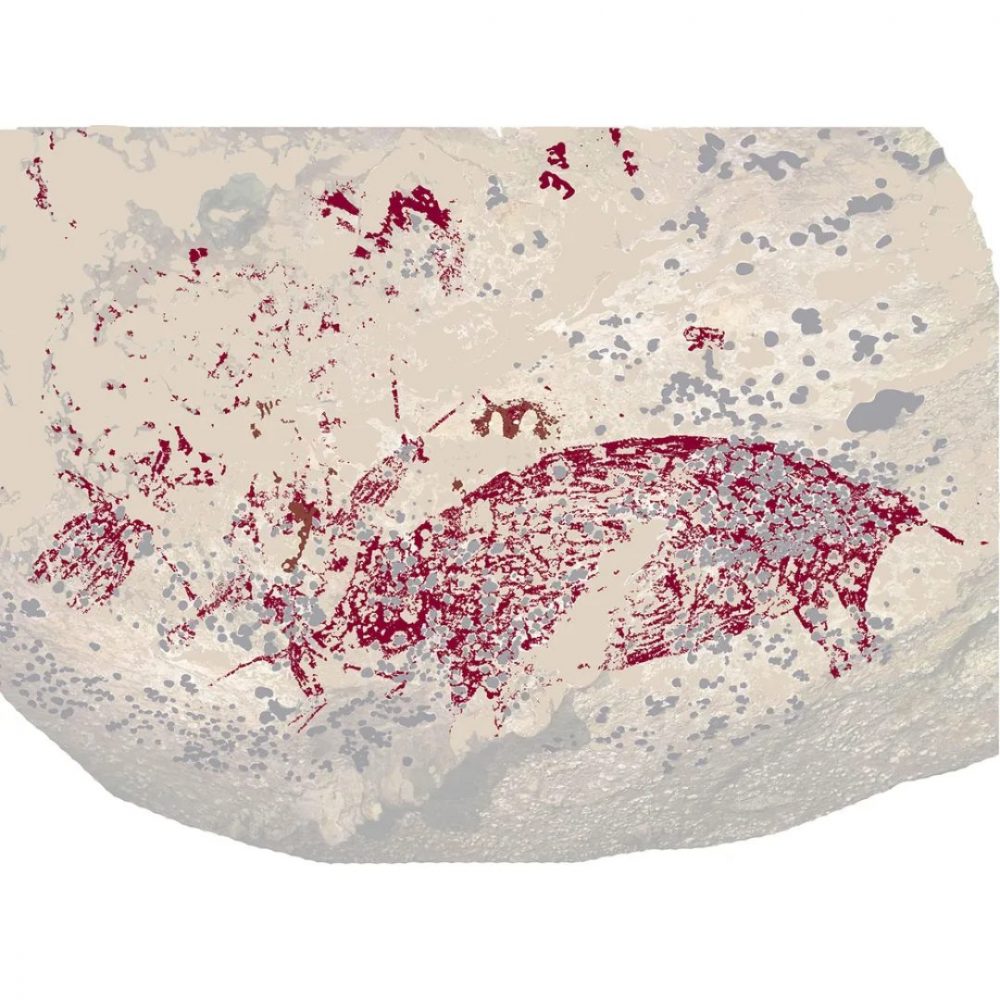
Cave Painting: 51,200-Year-Old Indonesian Find
Recommended for Prehistoric Art
Hey curious enthusiasts, gather around the virtual campfire because we, your friendly neighborhood storytellers, have an amazing tale to share. Picture this: a hidden cave on a remote Indonesian island, Sulawesi, to be exact. Now, imagine stumbling upon a painting on the cave wall that’s so old, it predates written language itself. Yeah, you heard that right – older than any book you’ve ever read!
Why should you care about some ancient scribbles on a cave wall? Well, this isn’t just any doodle; it’s potentially the oldest visual story ever told by humans. Forget Netflix, this is storytelling at its finest. We’re talking about a scene that depicts human-like figures interacting with a wild pig, frozen in time for over 51,200 years. That’s right, FIFTY-ONE THOUSAND TWO HUNDRED years ago!
These early artists weren’t just bored cave dwellers; they were storytellers, using pigments made from natural materials like charcoal and ochre to create a narrative that has echoed through the ages.
So, who should tune into this tale? Honestly, anyone with a curious mind and a love for history, art, or just plain fascinating stuff. If you’re an art enthusiast, this discovery is a treasure trove of ancient creativity. History buffs, you’ll get a glimpse into the lives of our ancestors, long before Instagram and TikTok.
And if you’re an anthropologist or archaeologist, well, buckle up, because this is groundbreaking stuff!
Sulawesi is a large Indonesian island known for its unique shape, resembling a lowercase letter ‘k’. It’s the eleventh largest island globally and boasts incredible biodiversity with many species found nowhere else. What is Sulawesi?
An anthropologist is a scientist who studies humans. They explore everything about people, from our ancient origins and how our bodies have changed over time, to the diverse cultures and societies we create today. Who is an anthropologist?
An archaeologist is a scientist who studies the past by excavating and examining objects left behind by ancient people. These objects, called artifacts, can be anything from tools and pottery to buildings and bones. Who is an archaeologist?
Listen to the news
Key facts
- How did scientists figure out the age of this masterpiece? They used a super cool, high-tech laser analysis technique to date the painting. This method is a game-changer, allowing researchers to analyze tiny samples of the rock art with incredible precision.
- Turns out, this painting is not only the oldest figurative art ever found but also predates another Indonesian cave painting of a pig by a whopping 5,700 years! That’s like finding out your great-great-great-great-great-great-grandpa was way older than you thought!
- But what’s the story behind the painting? Well, that’s where things get really interesting. The scene depicts three human-like figures seemingly interacting with a wild pig. It’s like a snapshot of a moment frozen in time, leaving us to wonder:
- Are they hunting the pig? Are they worshipping it? Or maybe it’s a scene from a long-lost myth? Whatever the story, it’s clear that these early humans had a complex understanding of the world around them and the ability to communicate ideas through visual imagery.
- So, what does all of this mean? It means we need to rethink our understanding of early human cognition and communication. The Sulawesi cave painting challenges the notion that complex storytelling emerged much later in human history. It suggests that our ancestors were capable of abstract thought and creative expression far earlier than we previously believed.
- And that, dear readers, is why this discovery is so freaking amazing. It’s a window into our past, a testament to human ingenuity and creativity, and a reminder that we’ve been telling stories since the dawn of time.
- So, whether you’re a history buff, an art lover, or just someone who appreciates a good yarn, this story is for you. It’s a reminder that we’re all part of a long and fascinating human narrative, one that’s been unfolding for millennia on cave walls, canvas, and now, on your screens.
- And remember, the next time you see a doodle on a napkin, don’t dismiss it as just a drawing – it could be the start of a story that lasts for millennia.
Related Stories
Watch a video
This video takes you on a virtual tour of the Bhimbetka rock shelters in India, which are similar in age and style to the Chauvet Cave paintings. It’s a fascinating exploration of ancient art and the lives of early humans.
Curious Times is a leading newspaper and website for kids. We publish daily global news aligned to your learning levels (also as per NEP 2020): Foundational, Preparatory (Primary), Middle and Senior. So, check out the News tab for this. We bring kids’ favourite Curious Times Weekly newspaper every weekend with top news, feature stories and kids’ contributions. Also, check out daily JokesPoke, Tongue Twisters, Word of the Day and Quote of the Day, kids need it all the time.
Curious Times News Program for Schools for FREE. Over 5,000 schools and teachers from all over the world have joined our programme so that students and teachers can get FREE Educative Newspaper. Here, kids can take part in world events and win prizes and certificates for free through their schools.
Moreover, schools are sharing important School News, like interviews with the principal, notices about new students, contests, and results, not just on social media but also on a news website for kids and other schools.
Thus, do not wait any further, sign-up for your school for FREE.
The following social media platforms allow you to communicate with us: WhatsApp, Instagram, Facebook, Youtube, Twitter, and LinkedIn.
0 (Please login to give a Curious Clap to your friend.)
